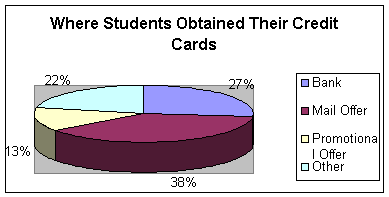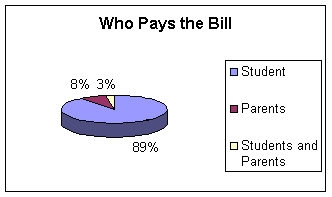COLLEGE
STUDENT CREDIT CARD USAGE AND THE NEED FOR
ON-CAMPUS FINANCIAL COUNSELING AND
PLANNING SERVICES
Julie Cunningham
Kansas State
University
Abstract
The purpose of this study was to examine the use of credit cards among college students and the need for on-campus financial counseling and planning services. The research objective was two-fold: (a) to determine if college students are responsible with their credit cards and (b) to evaluate the need for on-campus financial counseling. Participants in the survey (N = 110) completed a survey consisting of various questions about students� use of credit cards. Results showed that while a majority of the students who completed the survey were very responsible with their credit cards, there was a group (composed mostly of women in social science areas of study) who were having significant credit problems. The paper concludes with suggestions regarding on-campus financial counseling services.
Introduction
College students face more than just academic struggles. They live in a world where they have to focus on additional activities beyond homework, papers, and good grades. To succeed at college, whether living on or off campus, students need to have money and they need to know how to manage it. For example, they need money for books, living expenses, activities, travel, and other expenses. Many students enter college with no prior experience of being in control of their own personal finances. For some students, balancing a checkbook is a new challenge--one they have never had to face before. There are also students who come to college and obtain a credit card for the first time with no guidance regarding good and bad uses of credit. Some of these students have had introductory courses in personal finances while others have not. Some observers of college trends have suggested that, based on college student finances, there is a need on college campuses for a place for students to turn to in order to gain knowledge of how to manage their personal finances (e.g., Doll, 2000).
The objective of this paper is twofold: First, to report on the financial (credit) behaviors of a sample of college students by examining credit usage differences based on gender, academic class standing, and college area of study factors. The second objective was to determine, based on the credit usage patterns of respondents, if a need exists for on-campus financial counseling and planning services. The research reported in this paper extends previous findings reported by Doll (2000) who indicated that financial counseling centers should be opened on university campuses.
Background Review
College Students and Credit Cards
The usage of credit cards by college students is a high priority research topic. There have been many articles and studies written about this issue. Some authors support allowing students to have their own credit cards, while others feel students are not dependable enough to have the responsibility of their own credit card. An Internet article titled �Student Credit Card Trap� (PIRG, 1998) suggests that students are targets for credit card companies. The article�s authors surveyed 1,260 students at 15 representative campuses around the country to obtain information about the credit usage of college students. They reported that 69% of students obtained credit cards in their own name, while 31% claimed that their parents either paid their credit card bills or co-signed at least one of their cards. Of the students responsible for their own cards, 16% reported paying only the minimum amount required for payment, while nine percent reported making late payments. They also found that students who were responsible for their own cards, and had obtained them from campus tables, had more cards and unpaid balances than those who had not. In a section of recommendations for college administrators, the authors recommended that credit card and debt education and counseling sessions should be made a regular part of campus programming, and that counseling should include helping students to develop a budget, giving suggestions on how to eliminate debt, and teaching responsible credit card usage.
In an article entitled �Age Discrimination Comes to Credit Cards,� Fargo (1997) reported that �Oklahoma State Senator Robert Milacek, R-Waukomis, introduced a bill in that state to ban card issuance to those under 21 unless they can prove they�re self-supporting� (p.104). Fargo went on to say that this type of bill is equivalent to age discrimination, and according to the Equal Credit OpportunityAct, it is also illegal. Fargo argued that most young adults are responsible card users. He reported that 59% of students pay off their card balances immediately, and of those students who don�t, 82% of those who know their balance carry $1,000 or less.
Not all college credit card observers agree with Fargo (1997). Roberts (1998) concluded the following: �To many, the money involved in credit card transactions is abstract and unreal� (p. 300). He went on to say that credit cards are very easily accessible to college students and are marketed very aggressively to college students. �Twenty percent of college students are estimated to have four or more credit cards� (p. 300), and �students with no jobs, income, credit history, or parental co-signer are being offered credit cards� (p. 301). Roberts suggested that a correlation with credit cards and increased compulsive buying habits are likely to lad to students possessing credit cards.
An Associated Press (AP) (2000) indicated that the marketing of credit cards on campuses poses greater threats than alcohol or sexually transmitted diseases. The AP article reported that some students are forced to cut back on their courses or spend more time working to pay off credit card debts. The article went on to report that roughly 70% of students at four-year universities have at least one credit card, and that the average revolving debt on these cards was more than $2,000, and that this may lead to students being forced to drop out of school to work in order to pay off debt.
Hayhoe, Leach, Turner, Gross, Bass, and Xiao (1997) also conducted a study on college students and credit card usage. They reported that 80% of the students had at least one credit card. Another 10% had more than seven cards, with two students having 18 cards. Only 27% of the respondents had taken a personal finance course, while 13% had received advice from a financial planner or credit counselor service. Of the students in the sample, 19% of the students with credit cards used their cards for cash advances. It was also reported that �the more credit cards a student has the more likely they are to have high levels of debt and need to obtain financial advice from a professional as well as in a personal finance course� (p.42). The authors concluded that �educators and financial counselors are not reaching students with the information they need to make responsible decisions about the use of credit� (p.44). This was interpreted to mean that these students need to be reached in order to prevent them from having future financial difficulties.
Turner (1998) found that 86% of students from a midwestern university had at least one credit card and carried a balance on three or more of their credit cards. Turner also found that only 28% of both males and females had taken a course in personal finance in high school or college. When asked what the students used their credit cards for, 22% of females and 24% of males responded that they used their credit cards for cash advances. Turner reported that on the card used most often, the mean credit limit was $3,125. Ten percent did not know their credit limit. Also, 33% of students did not know the interest rate on the card used most often. Interestingly, Turner found that only 25% of males and 34% of females described themselves as being very or extremely secure when asked to assess their �Perceived Economic Well-Being.� Eight percent of males and ten percent of females perceived themselves as being very or extremely insecure. When asked about average debts, Turner reported that the average amount charged each month was $190.12, with a median amount of $90. She also found that 28% of women and 45% of men never used a written budget.
Campus Counseling Centers
Doll (2000) documented the need for financial counseling and planning services on university campuses. He determined that students and others would be interested in receiving assistance related to investing, establishing goals, paying off debt, and establishing good credit skills, among other factors. Doll concluded that a center should be opened on The Ohio State University campus, and that such a center should focus on the needs of students and staff.
Pilcher and Haines (2000) also documented the need for on-campus financial counseling center. They concluded that students who exhibited worse credit behaviors were more likely to benefit from peer financial counseling. They also documented that an organized counseling program can have a significantly positive impact on the well being of students.
Finally, Zhou and Su (2000) determined that students with debt and debt related problems were more likely to need and desire financial education. They concluded that �students will seek financial education and advice in reaction to perceived or actual credit problems� (p. 139). They recommended that universities take proactive steps to provide financial education and counseling to students, especially those who are experiencing or are likely to experience credit difficulties.
Summary
The literature suggests that, for the most part, college students are responsible in their use of credit cards and other forms of debt; however, there is evidence to suggest that a sizeable cohort of students (approximately 10% to 15%) exhibit problem behaviors in relation to credit card usage. Researchers such as Doll (2000) and Zhou and Su (2000) have drawn a link between negative credit behaviors and the need for on-campus financial counseling and planning services. The following discussion highlights the methodology and results from a study designed to further examine the credit card usage among college students with the intent of determining the need for on-campus financial counseling and planning services.
Methodology
A survey, using a convenience sample of 120 college students from a large Midwestern university, was used for the purpose of this study. Students received a credit card usage and counseling center need survey. A response rate in excess of 90% was obtained, with 110 students responding. Differences in credit card usage among students were examined by gender, academic class standing, and college area of study.
Sample
The characteristics of the sample in this study resembled closely the demographic characteristics reported by others (e.g., Hayhoe et al., 1997); however, in this sample, more women than men responded to the survey than reported in other studies. In general, the average respondent was typical of a U.S. undergraduate student. For example, less than 8% of students were married (Table 1).
Table 1 - Sample Characteristics
|
Student Characteristic |
Mean or Number |
|
Gender (1 = Women) |
80.90% |
|
Marital Status (1 = Married) |
7.30% |
|
University Class |
|
|
College Area of Study (1 = Agriculture, Business, Technology) |
26.50% |
Assessment Instrument and Data AnalysisSurvey respondents were asked a series of questions regarding their use of credit cards. Descriptive data were used to describe respondents� credit card behaviors. T-tests were then used to examine differences in credit card usage based on gender, academic class standing, and college area of study enrollment. Three variables were examined using t-tests: (a) the number of credit cards held by students, (b) how often balances were carried on cards, and (c) how many late payments students exhibited on credit cards. For the purpose of these tests, women were coded 1, otherwise 0. Juniors and Seniors were coded 1, while Freshmen and Sophomores were coded 0. Finally, those who were enrolled in a college of agriculture, business, or technology were coded 1, otherwise 0. This coding was used to classify students into �hard science� and �social science� categories.
It was hypothesized that there would be no differences in the number of credit cards held by students based on gender or college enrollment, but that Juniors and Seniors would hold more credit cards than others. This last hypothesis was based on the assumption that Junior and Senior students would inherently have more time to accumulate credit cards and knowledge about credit. It was also hypothesized that no differences would be found among the groups related to how often balances were carried on cards or in the number of late payments exhibited by students.
Findings
As shown in Table 2, the average credit card balance indicated by respondents was $671.86. The mean interest rate on cards held by students was 10.37%, while students reported an average total credit card limit of $1,850.41.
Table 2 - Credit Card Characteristics
|
Credit Characteristic |
Mean / Median / SD |
|
Credit Card Balance |
$671.86 / $250.00 / $1,072.89 |
|
Interest Rate |
10.37% / 12.50% / 7.68% |
|
Credit Limit |
$1,850.14 / $1,000.00 / $2,244.64 |
It was determined that 69% of students had one or more credit cards (Figure 1). A surprising large number of students (31%) reported having no credit cards in their own name.
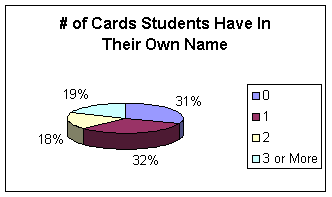
Figure 1: Number of Credit Cards Students Have in Their Own Name
Students obtained their credit cards from a number of sources (Figure 2). Thirty-eight percent of students received a credit card through a mail offer. Slightly fewer students received their card through a bank. Other students received credit cards through promotional offers and other sources. It was determined, through follow-up interviews with some sample respondents, that promotional offers included on-campus solicitation.
Figure 2: Where Students Obtained Their Credit Cards
Results also indicated that a majority of students in this study were responsible for paying their own credit card bill (Figure 3). Only eight percent of students relied on their parents to pay their credit card debt, and even fewer (3%) reported co-paying debt with parents.
Figure 3: Who Pays the Bill on the Credit Cards
Students reported a variety of reasons for using their credit cards (Figure 4). Most students (52%) used their credit card(s) for convenience. Other popular reasons indicated by students included use for special occasions (16%), emergencies (14%), and to make ends meet (9%).
Figure 4: What Students Use Their Credit Cards For
It was also determined that a fairly large number of students (58%) carry a revolving balance (Figure 5). More positively, however, 42% of students reported never carrying a revolving credit card balance.
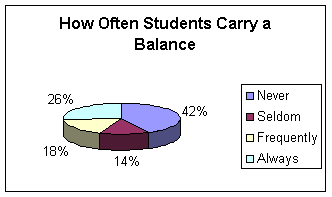
Figure 5: How Often Students Carry a Balance
Tied to findings related to balances carried by students, Figure 6 shows that about 33% of students indicated having made a late payment at least once in the past year. This is alarming because college students are a group that can least afford charges and fees associated with late payments. On a more positive note the majority of students (67%) reported perfect credit card payment behaviors.
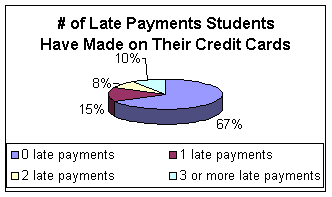
Figure 6: Number of Late Payments Students Have Made on Their Credit Cards
The majority of students (76%) surveyed also tended to pay more than the minimum balance on a regular basis (Figure 7). Less than five percent of respondents indicated that they pay off their balances each month.
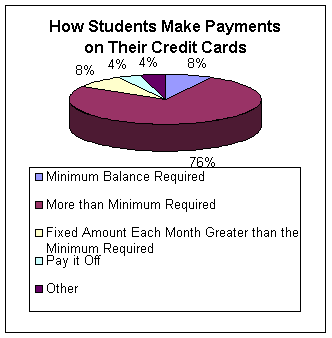
Figure 7: How Students Make Payments on Their Credit Cards
T-test results indicated that differences between men and women were only significant in terms of the number of late payments reported by respondents. Women were significantly more likely to report more late payments than men (t = -2.45, df = 42.63). This finding was contrary to the hypothesis that no differences would be found in terms of gender. On the other hand, the hypothesis that Juniors and Seniors would possess more credit cards was substantiated. Juniors and Seniors held more credit cards in their name than Freshmen and Sophomores (2.91 vs. 2.50, respectively) (t = -1.92, df = 30.18). Finally, social science majors (e.g., human ecology, education, arts and sciences) were found to have made more late payments on credit cards than �hard science� majors (e.g., agriculture and business) (t = 3.89, df = 70.72). This finding was also contrary to the hypothesis that no differences would be found in terms of late payments.
Summary and Discussion
Results from this survey suggest an alarmingly sizable portion of college students face serious credit threats that demand remedial counseling. While some students in this survey were managing their credit wisely, others were struggling with their finances. Also, students� knowledge about their personal finances and use of credit was limited. Take, for example, the following findings from the survey. Nine percent of the students who responded to the survey used credit cards for everyday purchases to make ends meet. Also, 25% of the students who had credit cards always carried a balance. Finally, over 31% of the students with credit cards had at least one late payment, with some students having more than one. This indicates that a larger number of students are struggling with their personal finances. These students who are experiencing difficulties with their personal finances appear to need an affordable way to get the assistance they need. An on-campus counseling center may open the doors they need by providing assistance with developing a budget and smart credit usage.
Results indicate that while the majority of students are doing well with their personal finances, there are some students who are not. There are students who are not using budgets. Others are making late payments on credit cards, or making only the minimum payments required on their credit cards. Other students rely on credit cards to make everyday purchases to make ends meet. In addition, it was determined, through a review of the literature and from findings from this study, that some students are getting into debt problems with credit cards, and at worst, some students may be forced to drop out of school and work full time.
Students with the greatest credit card problems tended to be women and those majoring in social science programs. This is alarming because social science majors, compared to agriculture, business, engineering, and technology college majors, will most likely earn less income during their careers. This situation is equally troubling in relation to findings related to gender. Women, like social science majors, are also more likely to earn less, over their working lives, than men. When combined, it appears that women social science majors not only exhibit worse credit card behaviors, but may also be likely to continue this trend after graduation.
Recommendation
An on-campus financial counseling center, as suggested by Doll (2000), would help improve the financial and consumer knowledge of students like those sampled in this study. This is particularly true for those students exhibiting the worse credit behaviors � women and social science majors. These type of students often lack the financial knowledge to adequately manage their personal debt. When people are in debt they tend to be stressed-out, have low self-esteem, suffer physical ailments, have a poor work ethic, have trouble concentrating, and many other negative problems (Hayhoe et al., 1997). Couple this with the stress that is already involved with college, and the negative social impacts can be considerable. If students are unable to pay for basic expenses, they may resort to excessive measures to pay for what they need. Students may have to work many hours to try to make ends meet. This extra working can infringe on study time, which could ultimately lead to poor performance in class. In addition, students with a lack of money may turn to credit cards for instant cash. This action, of course, can lead to ample credit card debt.
Almost every student accumulates some kind of debt before they leave college. This debt is usually comprised of student loans, credit card debt, or both. This makes for a tough situation when graduation day arrives. Students have spent four, or more, years with a specific goal in mind. They want a job that will pay a suitable amount of money after they receive their degree. However, reaching this goal usually takes longer than expected. With high student loans and/or credit card debt, discretionary income is minimal.
With rising tuition and living costs, accumulating some kind of debt is almost unavoidable. Students often cannot afford to avoid loans and/or credit cards altogether. The answer is not to sacrifice an education to elude debt. Students need to know how to manage the money that they currently have. They need the tools necessary to help them manage the debt that they do have.
As suggested in this paper, approximately 10% of students are in serious debt to the point where they have difficulty paying their bills and their credit is damaged. This means that out of the 20,000+ students on a typical land-grant university campus, around 2,000 may have substantial difficulty managing their money. This percentage may seem small, but the number of people who feel the effects of bad debt are numerous. Today, these 2,000 people have few options for help. They can go to a consumer credit agency, but this alternative sometimes costs money and many students may not even realize that such a service is available. A counseling center on campus would offer a more comprehensive individualized plan that would suit each student�s needs. A financial counseling center on campus could offer many different services, ranging from simple budgeting techniques to detailed financial planning. The center would not only be a valuable resource for students, but for the community as well. Some services that a center could offer include the following:
Budgeting. A budget is a plan that helps to control cash inflows and cash outflows. It is set up to keep expenditures in line with income. Clients would receive help concerning how to set up and implement a spending plan. Suggested spending guidelines would be offered, and clients could witness first-hand how keeping track of their money can lessen overspending habits.
Credit Cards. This service would include information about credit cards including: Fees, interest rates, interest charges, grace periods, cash advances, and controlling and managing strategies. Clients would receive extensive debt counseling that would include debt consolidation and help in determining which credit card would be best fit their current financial situation.
Time Value of Money. Understanding how the passage of time affects the value of money is crucial. Clients would be shown how to use calculators and/or computer programs, how money grows over time, and more specifically, how their money could grow over time.
Student Loans. Clients would calculate, using time value of money concepts, the amount of their monthly loan payments. Using this knowledge, clients would determine what level of living can be attained after graduation.
Personal Loans. Clients would receive information about mortgages, car loans, and personal loans. Clients could determine how much their monthly payments would be, what they could afford for a house or car, and how to qualify for a mortgage.
Credit Report Information. Information on obtaining a credit report and the importance of viewing a credit report would be extended to clients.
Financial Planning. This service would be much more detailed, and would require a greater fee than the services listed above. Clients would receive information on a wide variety of topics including: Cash management, retirement planning, estate planning, debt consolidation, loan counseling, investment strategies, insurance analyses, and any other area of their financial situation that may need attention.
Implementation Strategy
Experiences from universities that have counseling centers (e.g., Iowa State University, Texas Tech University, Utah State University) indicate that funding a financial counseling center is the greatest obstacle next to setting one up. Donations can be encouraged, but substantial state aid is typically necessary. As suggested above, students tend to only use a service if it is free or very low cost. For this to happen, student fees might need to be increased.
A fee schedule for non-students can be implemented. This fee schedule can be based on income and number of dependents. To assure that people in the community would use a center, fees should only be enough to cover basic office expenses. A center should be a non-profit organization. Clients who would want to receive financial planning services would need to pay a higher fee than counseling clients. However, this fee should not be substantially higher. It should be based on income, number of dependents, and time spent on the plan by the planner.
Another concern involves staffing. One solution is student staffing. This solution offers a great opportunity for financial counseling and planning students to really experience first-hand what they are learning about in class. Several options can be available for financial counseling and planning students. They can do internships in a center. They can also work at a center, un-paid, and receive college credit. This alleviates concerns about paying employees a wage. This approach is also a wonderful chance for financial counseling and planning students to gain knowledge in their field while still in college. This experience should prove positive when interviewing with prospective employers. These extra credentials should be very impressive and desirable in the workforce.
The exciting aspect about having a financial counseling center on campus is that it would be accessible to all students. It is a mistake to focus mainly on those who are heavily indebted, because there are many students who need help in areas that do not necessarily revolve around debt. They may just need advice about how to get a car loan, to figure out how much their student loan repayment will be, or how to make and implement a budget. Right now, there is not an on-campus location that a student can go to seek answers to these questions on most campuses. There are some personal finance courses available on campus, but not every student can take them; class space is always limited. Moreover, students would reap more benefits from advice on a personal, confidential, one-on-one basis. A student cannot receive much guidance on their own personal situation in a classroom full of other students.
Summary
College offers many advantages for students. Students receive an education that extends beyond their chosen major, and they are introduced to activities and opportunities. This experience should be heightened, though. Students should also learn how to cope with their finances. They should understand how to manage their money when they head out into the �real world�. Personal finance is a fundamental part of life. Not introducing such an important concept that will affect every facet of a person�s life is disparaging. Something can be done about this, though. Assembling a financial counseling center would offer students an education that they could use for the rest of their lives, regardless of where they live or what job they have. They would possess the necessary skills to lead a more successful and less stressful life.
References
Associated Press. (2000, June, 12, 2000). Should credit be marketed to kids? The Manhattan Mercury, p. A8.
Doll, K. M. (2000). Who would use financial counseling and planning services on university campuses? Evidence from students, staff and faculty. Proceedings of Association for Financial Counseling and Planning Education, 122 � 131.
Fargo, J. (1997). Age Discrimination Comes to Credit Cards. Afterthoughts, 104.
Hayhoe, C. R., Leach, L., Turner, P. S., Gross, P. E., Bass, B., Xiao, J. J. (1997). College students� use of credit cards: A descriptive study. Proceedings of Association for Financial Counseling and Planning Education, 42-45.
PIRG. (1998). The campus credit card trap. Retrieved September 30, 2000 from the World Wide Web: http://www.pirg.org/student/consumer/credit98/page1.html
Pilcher, A. M., Haines, T. (2000). Peer financial counseling: From one student to another. Proceedings of Association for Financial Counseling and Planning Education, 132.
Roberts, J. A. (1998). Compulsive buying among college students: An investigation of its antecedents, consequences, and implications for public policy. The Journal of Consumer Affairs, 32 (2), 295-317.
Turner, Pamela. (1998). Personal Internet Interview.
Zhou, L., & Hung-Jen, S. (2000). Predicting college student debt: An exploratory study on sociodemographic, economic, attitudinal, and behavioral determinants. Proceedings of Association for Financial Counseling and Planning Education, 133- 140.
|
|
|
©2002-2021 All rights reserved by the Undergraduate Research Community. |
